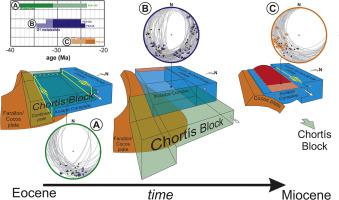Tectonophysics ( IF 2.9 ) Pub Date : 2021-07-27 , DOI: 10.1016/j.tecto.2021.229004 Tomás A. Peña-Alonso 1 , Carolina Latorre 2 , Juliana Estrada-Carmona 3 , Roberto S. Molina-Garza 3 , Luigi Solari 3

|
Three successive strain regimes spanning up to ~16 million years were identified from the field, structural and geochronological analyses in Upper Eocene-Oligocene migmatites of the Xolapa Complex around the Puerto Escondido longitude (~97°W), in southern Mexico. A west-facing asymmetric folding affecting diatexites at ca. 38–31 Mad defines Regime A. Regimes B and C affected younger metatexites. Regime B recorded an outward extension at ca. 31–25 Ma, whereas Regime C occurred at ca. 25–22 Ma as NE-directed thrusting. By coupling the Upper Cretaceous-Oligocene tectonic framework of southern Mexico with the dynamics and timing of the identified strain regimes, we interpret that Regimes A to C recorded distinct stages of the separation and eastward migration of the Chortís Block, viewed as a continuous geodynamic episode. According to our proposal, the upper and lower crust of Chortís adjacent to nuclear Mexico were vertically decoupled before its separation by the presence of pre-Eocene crustal anisotropies. Regime A occurred when the Chortís Block rode over the Xolapa Complex during its initial eastward escape. Since this episode, the Chortís Block (upper crust) was captured by the Caribbean plate, whereas the Xolapa Complex (lower crust) remained as the southernmost North America plate. Chortís eastward migration and the consequent unloading of its decoupled lower crust triggered anatexis, isostatic adjustments, and diachronous uplift of the Xolapa Complex (Regime B). The progressive substitution of Chortís by its thinner lower crust in the tectonic configuration next to nuclear Mexico gradually enhanced the local convergence rate between the Farallon/Cocos plate and just-severed North America. The Farallon/Cocos plate was accreted to North America (Regime C) after a critical lengthening of the uprising lower crust along the southern Mexican margin. The local increase of the convergence rate promoted the landward consumption of the Xolapa Complex by subduction erosion since 22 Ma.
中文翻译:

Xolapa 变质带(Puerto Escondido,墨西哥)中的多阶段、上始新世-渐新世 anatexis:Xolapa 杂岩体在构造迁移过程中作为 Chortís 地块上地壳解耦下地壳的动力学
从墨西哥南部波多埃斯孔迪多经度 (~97°W) 周围 Xolapa 杂岩群的上始新世-渐新世混合岩的野外、结构和地质年代学分析中确定了三个连续的应变状态,时间跨度长达约 1600 万年。一个朝西的不对称折叠影响大约在 diatexites。38-31 Mad 定义了状态 A。状态 B 和 C 影响了较年轻的超纺织物。制度 B 在约 31-25 Ma,而Regime C发生在ca。25-22 Ma 作为 NE 定向推力。通过将墨西哥南部的上白垩统-渐新世构造框架与已识别应变机制的动力学和时间相结合,我们解释了机制 A 到 C 记录了 Chortís 地块分离和向东迁移的不同阶段,被视为连续的地球动力学事件. 根据我们的提议,由于始新世前地壳各向异性的存在,与核墨西哥相邻的乔蒂斯的上地壳和下地壳在分离之前垂直分离。政权 A 发生在 Chortís Block 在其最初向东逃逸期间骑过 Xolapa Complex 时。自这一事件以来,Chortís Block(上地壳)被加勒比板块捕获,而 Xolapa Complex(下地壳)仍然是北美最南端的板块。Chort 的向东迁移和随后解耦的下地壳的卸载引发了 Xolapa 杂岩体(区域 B)的厌氧、均衡调整和历时抬升。在靠近核墨西哥的构造构造中,Chortís 逐渐被其较薄的下地壳取代,逐渐增强了 Farallon/Cocos 板块与刚刚切断的北美之间的局部收敛速度。法拉隆/科科斯板块在沿墨西哥南部边缘的起义下地壳发生临界延长后被吸积到北美(区域 C)。22 Ma以来,收敛速度的局部增加促进了Xolapa杂岩通过俯冲侵蚀向陆消耗。


























 京公网安备 11010802027423号
京公网安备 11010802027423号